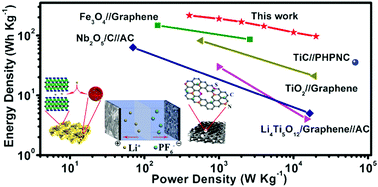当前位置:
X-MOL 学术
›
Mater. Chem. Front.
›
论文详情
Our official English website, www.x-mol.net, welcomes your
feedback! (Note: you will need to create a separate account there.)
A novel lithium-ion hybrid capacitor based on an aerogel-like MXene wrapped Fe2O3 nanosphere anode and a 3D nitrogen sulphur dual-doped porous carbon cathode†
Materials Chemistry Frontiers ( IF 6.0 ) Pub Date : 2018-07-18 00:00:00 , DOI: 10.1039/c8qm00232k Xiao Tang 1, 2, 3, 4, 5 , Hao Liu 1, 2, 3, 4, 5 , Xin Guo 1, 2, 3, 4, 5 , Shijian Wang 6, 7, 8, 9 , Wenjian Wu 6, 7, 8, 9 , Anjon Kumar Mondal 1, 2, 3, 4, 5 , Chengyin Wang 9, 10, 11, 12 , Guoxiu Wang 1, 2, 3, 4, 5
Materials Chemistry Frontiers ( IF 6.0 ) Pub Date : 2018-07-18 00:00:00 , DOI: 10.1039/c8qm00232k Xiao Tang 1, 2, 3, 4, 5 , Hao Liu 1, 2, 3, 4, 5 , Xin Guo 1, 2, 3, 4, 5 , Shijian Wang 6, 7, 8, 9 , Wenjian Wu 6, 7, 8, 9 , Anjon Kumar Mondal 1, 2, 3, 4, 5 , Chengyin Wang 9, 10, 11, 12 , Guoxiu Wang 1, 2, 3, 4, 5
Affiliation

|
Lithium-ion capacitors (LICs) have emerged as promising energy storage devices with both high energy density and high power density. However, due to the mismatch of charge-storage capacity and electrode kinetics between battery-type anodes and capacitor-type cathodes, the application of lithium-ion capacitors has been limited. In this work, interconnected aerogel-like MXene wrapped Fe2O3 nanospheres have been prepared and investigated as battery-type anode materials for lithium-ion capacitors. In this rationally designed hybrid electrode, the Ti3C2Tx MXene matrix is capable of providing fast transport of electrons and suppressing the volume change of Fe2O3. Simultaneously, Fe2O3 hollow nanospheres offer large specific capacity and prevent restacking of the MXene layers, synergizing to boost the electrochemical performances of such hybrid electrodes. Meanwhile, the three-dimensional (3-D) nitrogen and sulphur dual-doped porous carbon (NS-DPC) derived from biomass has also been fabricated as a capacitor-type cathode material for lithium-ion capacitors. Consequently, the lithium-ion capacitors can demonstrate a high energy density of 216 W h kg−1 at a power density of 400 W kg−1 and a high power density of 20 kW kg−1 at an energy density of 96.5 W h kg−1. This work elucidates that both high energy density and power density can be achieved in hybrid lithium-ion capacitors.
中文翻译:

基于气凝胶状MXene包裹的Fe 2 O 3纳米球阳极和3D氮硫双掺杂多孔碳阴极的新型锂离子混合电容器†
锂离子电容器(LICs)已成为具有高能量密度和高功率密度的有前途的储能设备。然而,由于电池型阳极和电容器型阴极之间的电荷存储容量和电极动力学的不匹配,限制了锂离子电容器的应用。在这项工作中,已经制备了互连的气凝胶状MXene包裹的Fe 2 O 3纳米球,并将其作为锂离子电容器的电池型阳极材料进行了研究。在这种合理设计的混合电极中,Ti 3 C 2 T x MXene基体能够提供快速的电子传输并抑制Fe 2 O 3的体积变化。。同时,Fe 2 O 3中空纳米球提供了大的比容量并防止了MXene层的重新堆积,从而协同作用增强了此类混合电极的电化学性能。同时,源自生物质的三维(3-D)氮和硫双掺杂多孔碳(NS-DPC)也已被制造为用于锂离子电容器的电容器型阴极材料。因此,锂离子电容器在400 W kg -1的功率密度下可以表现出216 W h kg -1的高能量密度,在96.5 W h kg的能量密度下可以表现出20 kW kg -1的高功率密度。-1。这项工作阐明了在混合锂离子电容器中既可以实现高能量密度又可以实现功率密度。
更新日期:2018-07-18
中文翻译:

基于气凝胶状MXene包裹的Fe 2 O 3纳米球阳极和3D氮硫双掺杂多孔碳阴极的新型锂离子混合电容器†
锂离子电容器(LICs)已成为具有高能量密度和高功率密度的有前途的储能设备。然而,由于电池型阳极和电容器型阴极之间的电荷存储容量和电极动力学的不匹配,限制了锂离子电容器的应用。在这项工作中,已经制备了互连的气凝胶状MXene包裹的Fe 2 O 3纳米球,并将其作为锂离子电容器的电池型阳极材料进行了研究。在这种合理设计的混合电极中,Ti 3 C 2 T x MXene基体能够提供快速的电子传输并抑制Fe 2 O 3的体积变化。。同时,Fe 2 O 3中空纳米球提供了大的比容量并防止了MXene层的重新堆积,从而协同作用增强了此类混合电极的电化学性能。同时,源自生物质的三维(3-D)氮和硫双掺杂多孔碳(NS-DPC)也已被制造为用于锂离子电容器的电容器型阴极材料。因此,锂离子电容器在400 W kg -1的功率密度下可以表现出216 W h kg -1的高能量密度,在96.5 W h kg的能量密度下可以表现出20 kW kg -1的高功率密度。-1。这项工作阐明了在混合锂离子电容器中既可以实现高能量密度又可以实现功率密度。











































 京公网安备 11010802027423号
京公网安备 11010802027423号